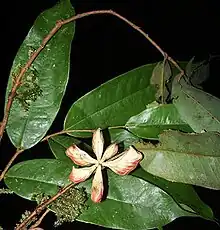Xylopia cuspidata
Xylopia cuspidata is a species of plant in the Annonaceae family. It is native to Bolivia, Brazil, Colombia, Ecuador and Peru.[3] Ludwig Diels, the botanist who first formally described the species, named it after the leaves which have an abruptly pointed tip (cuspidatus in Latin).[4][5]
| Xylopia cuspidata | |
|---|---|
 | |
| Photograph of Xylopia cuspidata with flower[1] | |
| Scientific classification | |
| Kingdom: | Plantae |
| Clade: | Tracheophytes |
| Clade: | Angiosperms |
| Clade: | Magnoliids |
| Order: | Magnoliales |
| Family: | Annonaceae |
| Genus: | Xylopia |
| Species: | X. cuspidata |
| Binomial name | |
| Xylopia cuspidata | |
| Synonyms | |
|
Uvaria febrifuga Humb. & Bonpl. ex DC. | |
Description
It is a large tree. The young rust-colored branches are hairy, but as their bark becomes dark brown. Its elliptical to oblong, papery leaves are 15-25 by 7-9 centimeters. The leaves have rounded to slightly tapering bases and rounded tips that terminate in a 3-4 centimeter-long pointed cusp. The leaves are hairless on their upper surfaces, and have soft hairs that lay flat on their lower surfaces. The leaves have 10 pairs of secondary veins emanating from their midribs. Its petioles are 3-6 millimeters long. Its Inflorescences occur in the axils of fallen leaves. Each inflorescence has 1 flower. Each flower is on a pedicel that is 6-7 millimeters long and covered in rust-colored hairs. The pedicels have bracts. Its flowers have 3 green, slightly membranous, sepals. The lower portion of the sepals are fused to form a 3-4 millimeter cup-shaped structure with 3 minute lobes. The sepals are covered in rust-colored hairs. Its 6 petals are arranged in two rows of 3. The pale yellow, triangular to egg-shaped, outer petals are 5 by 8 millimeters with pointed tips. The outer surface of the outer petals are covered in silky hairs. The pale yellow, lance-shaped inner petals are 12.5 by 6.5 millimeters. The flowers have pale yellow stamens. The flowers have numerous hairy carpels with 4-5 ovules. The carpels have club-shaped styles that are 4-5 millimeters long, and hairless stigmas that are held together by a glutinous exudate.[5][6]
Reproductive biology
The pollen of Xylopia cuspidata is shed as permanent tetrads.[7]
Distribution and habitat
It has been observed growing in high forests and bushlands at elevations of 110 meters.[5]
Uses
Based on interviews with traditional healers in Peru extracts from the bark and leaves have been recorded as being used to treat rheumatism.[8]
References
- "Xylopia cuspidata Diels". Tropicos. Tropicos.org. Missouri Botanical Garden. n.d. Retrieved August 20, 2023.
- Verspagen, N. & Erkens, R.H.J. (2020). "Xylopia cuspidata". IUCN Red List of Threatened Species. 2020: e.T140932863A140932865. doi:10.2305/IUCN.UK.2020-3.RLTS.T140932863A140932865.en. Retrieved 17 June 2022.
{{cite journal}}: CS1 maint: multiple names: authors list (link) - "Xylopia cuspidata Diels". Plants of the World Online. The Trustees of the Royal Botanic Gardens, Kew. n.d. Retrieved June 17, 2022.
- Stearn, William (2004). Botanical Latin. Portland, Ore. Newton Abbot: Timber Press David & Charles. ISBN 9780881926279.
- Diels, L. (1927). Mildbraed, J. (ed.). "Plantae Tessmannianae peruvianae VI" [Plants of Tessmanniana VI]. Notizblatt des Königlichen botanischen Gartens und Museums zu Berlin (in German and Latin). 10 (92): 169–197. doi:10.2307/3994717. JSTOR 3994717.
- Macbride, J. Francis (1938). Flora of Peru. Chicago: Field Museum Press. p. 747.
- Walker, James W. (1971). "Pollen Morphology, Phytogeography, and Phylogeny of the Annonaceae". Contributions from the Gray Herbarium of Harvard University. 202 (202): 1–130. doi:10.5962/p.272704. JSTOR 41764703. S2CID 249081277.
- Sanz-Biset, Juame; Campos-de-la-Cruz, José; Epiquién-Rivera, Mirbel A.; Cañigueral, Salvador (2009). "A first survey on the medicinal plants of the Chazuta valley (Peruvian Amazon)". Journal of Ethnopharmacology. 122 (2): 333–362. doi:10.1016/j.jep.2008.12.009. PMID 19146943.
